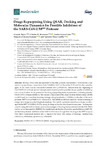Mostrar o rexistro simple do ítem
Drugs Repurposing Using QSAR, Docking and Molecular Dynamics for Possible Inhibitors of the SARS-CoV-2 Mpro Protease
| dc.contributor.author | Tejera, Eduardo | |
| dc.contributor.author | Munteanu, Cristian-Robert | |
| dc.contributor.author | López-Cortés, Andrés | |
| dc.contributor.author | Cabrera-Andrade, Alejandro | |
| dc.contributor.author | Pérez-Castillo, Yunierkis | |
| dc.date.accessioned | 2020-12-21T15:55:19Z | |
| dc.date.available | 2020-12-21T15:55:19Z | |
| dc.date.issued | 2020-11-06 | |
| dc.identifier.citation | Tejera, E.; Munteanu, C.R.; López-Cortés, A.; Cabrera-Andrade, A.; Pérez-Castillo, Y. Drugs Repurposing Using QSAR, Docking and Molecular Dynamics for Possible Inhibitors of the SARS-CoV-2 Mpro Protease. Molecules 2020, 25, 5172. | es_ES |
| dc.identifier.issn | 1420-3049 | |
| dc.identifier.uri | http://hdl.handle.net/2183/26999 | |
| dc.description.abstract | [Abstract] Wuhan, China was the epicenter of the first zoonotic transmission of the severe acute respiratory syndrome coronavirus clade 2 (SARS-CoV-2) in December 2019 and it is the causative agent of the novel human coronavirus disease 2019 (COVID-19). Almost from the beginning of the COVID-19 outbreak several attempts were made to predict possible drugs capable of inhibiting the virus replication. In the present work a drug repurposing study is performed to identify potential SARS-CoV-2 protease inhibitors. We created a Quantitative Structure–Activity Relationship (QSAR) model based on a machine learning strategy using hundreds of inhibitor molecules of the main protease (Mpro) of the SARS-CoV coronavirus. The QSAR model was used for virtual screening of a large list of drugs from the DrugBank database. The best 20 candidates were then evaluated in-silico against the Mpro of SARS-CoV-2 by using docking and molecular dynamics analyses. Docking was done by using the Gold software, and the free energies of binding were predicted with the MM-PBSA method as implemented in AMBER. Our results indicate that levothyroxine, amobarbital and ABP-700 are the best potential inhibitors of the SARS-CoV-2 virus through their binding to the Mpro enzyme. Five other compounds showed also a negative but small free energy of binding: nikethamide, nifurtimox, rebimastat, apomine and rebastinib. | es_ES |
| dc.description.sponsorship | Universidad de Las Américas (Quito, Ecuador); BIO.TPA.20.03 | es_ES |
| dc.description.sponsorship | Instituto de Salud Carlos III; PI17/01826 | es_ES |
| dc.description.sponsorship | Xunta de Galicia; ED431C 2018/49 | es_ES |
| dc.language.iso | eng | es_ES |
| dc.publisher | MDPI AG | es_ES |
| dc.relation.uri | https://doi.org/10.3390/molecules25215172 | es_ES |
| dc.rights | Atribución 4.0 Internacional (CC BY) | es_ES |
| dc.rights.uri | https://creativecommons.org/licenses/by/4.0/ | * |
| dc.subject | SARS-CoV-2 | es_ES |
| dc.subject | COVID-19 | es_ES |
| dc.subject | QSAR | es_ES |
| dc.subject | Drugs repurposing | es_ES |
| dc.subject | Molecular dynamics | es_ES |
| dc.title | Drugs Repurposing Using QSAR, Docking and Molecular Dynamics for Possible Inhibitors of the SARS-CoV-2 Mpro Protease | es_ES |
| dc.type | info:eu-repo/semantics/article | es_ES |
| dc.rights.access | info:eu-repo/semantics/openAccess | es_ES |
| UDC.journalTitle | Molecules | es_ES |
| UDC.volume | 25 | es_ES |
| UDC.issue | 21 | es_ES |
| UDC.startPage | 5172 | es_ES |
| dc.identifier.doi | 10.3390/molecules25215172 |
Ficheiros no ítem
Este ítem aparece na(s) seguinte(s) colección(s)
-
GI-RNASA - Artigos [193]






